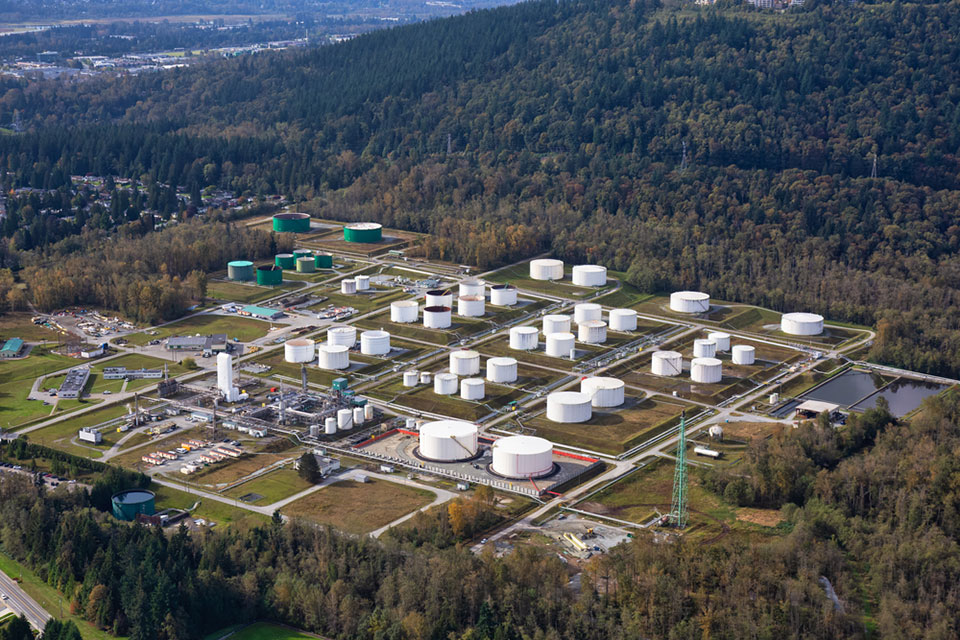Canada’s turning point for energy and natural resources is now

In the midst of an increasingly volatile geopolitical environment, Canada has a unique opportunity to foster energy security abroad while leading the energy transition at home. These priorities are not mutually exclusive. Rather, Canadian stakeholders can — and should — focus on decarbonization while also working to solve today’s urgent global oil and gas demand challenges.
Why? The human toll of the war in Ukraine is paramount. Yet, even as countries, including Canada, rally to provide humanitarian aid, impose sanctions and shelter millions of refugees, this crisis is already creating lasting economic impacts. From slowing growth to financial market disruption, heightened cyber risk to trade barriers, food insecurity to inflation: the list is long. And those ripple effects are increasingly pronounced across energy and commodity access and pricing:
- In Europe, nearly 40% of natural gas and 25% of oil originates in Russia.
- The US imports 35% of its palladium, which is used in fuel cells, from Russia.
- Countries like Turkey, the Netherlands, Hungary, Kazakhstan and Poland also draw significant resources from Russian pipelines.
- The United States banned Russian oil, gas and coal this spring and the United Kingdom announced a phase-out of Russian oil by the end of 2022. Up until now, these nations were heavy importers as well.
- To be clear, any fall in the energy supply could shake up everything from industrial production capabilities to consumer energy bills well beyond Germany, Italy and Belarus, which import the most Russian oil.
Taken together, the international nature of vast reliance on Russian energy and natural resources means it could take until 2028 to stabilize the situation and an additional 20 years to get the sector back to a pre-war status quo. Enter the opportunity for Canada to build on broader aid commitments by embracing a different leadership role — one that cultivates greater energy security for more countries, all while redefining what the domestic energy sector can be from here on out.
How could that take shape? As a country that produced 5.1 million barrels of crude oil daily in 2020, Canada is fourth in the world in terms of production. At the same time, Canada ranks third in terms of oil reserves. What’s more, as of 2017, this country held 77 trillion cubic feet (TcF) of proven gas reserves, representing about 1% of all natural gas reserves on the planet. That’s equivalent to 17.5 times Canada’s annual natural gas consumption. This means a whole lot of capacity in a market where the US is actively pursuing new import possibilities with Venezuela and Iran, and the UK is pushing OPEC to increase production. The fact that World Bank Governance Indicators and the Yale Environmental Performance Index rank Canada as the world leader among oil-producing countries on environmental, social and governance (ESG) standards makes this country an even more attractive and viable source of oil and gas imports.
Things are already shifting. The Canadian Government just announced production increases of 300,000 barrels of oil equivalent (boe) per day. Whether that will be enough remains to be seen. Ramping up production and exports even further could simultaneously create jobs, bolster domestic economic growth and generate additional cash flow — building on five years of successful industry cost-cutting — to reinvest in transforming the Canadian sector and national energy grid for the future.
The business case is clear. But time is of the essence. Embracing this direction requires stakeholders — from energy company leadership right through to parliamentary policymakers — to consider critical questions now and align around a path forward quickly:
- Does Canada have the political and economic will to consider the long-term energy security we can provide to Europe and the US and the ability to get mega projects done?
With 179 billion barrels of oil in reserve, Canada has a lot to offer right now. Even within Canada, energy independence is becoming increasingly top of mind. Some 52% of Québeckers think their province should develop its own oil resources instead of importing the oil consumed locally. That’s up 9% from just one year ago. Let’s dare to ask how we can play a global and national leadership role by broaching growing resource gaps with made-in-Canada energy security solutions. Many observers will say Canada’s inability to build facilities and pipelines caused this country to miss the boat on liquified natural gas. Without clear consensus, similar obstacles could affect future plans. - How will OPEC’s response to calls for increased production impact prices and inflationary pressures here and everywhere?
The Bank of Canada is already focused on rising inflation. Time and time again, historical oil price surges precede recessions. Even as Saudi Arabia announces investments to increase production, the train of economic impacts has clearly left the station. Counteracting these ripple effects through homegrown solutions can create new ways of evolving in the face of rising costs across the board. - What does today’s geopolitical crisis mean for the energy transition, and will it accelerate as a consequence of the reliance on Russian energy sources?
The energy transition represents bold ambitions that will take shape over time. Before recent sanctions, Canada imported roughly $550 million worth of Russian crude annually. Seizing this tumultuous moment to let go of the reliance on foreign hydrocarbons and think more broadly about new energy supply sources like hydrogen, can help countries like Canada speed up the move toward a clean energy future. Exploring these opportunities can be an essential springboard to reinventing any nation’s energy strategy. - Where should the Canadian oil and gas sector’s cash go next, given that large mega projects remain on the backburner?
The cost of producing oil is dramatically lower in Canada than 10 years ago. Players can afford to shift away from paying down debt, increased dividends and buying back shares to focus on transforming decarbonization across the value chain. Whether through new engineering solutions like carbon capture, utilization and storage (CCUS), business models, reduced flaring, electrification or expansions into alternative energy sources like solar, wind or hydrogen capabilities: there are endless ways to abandon the same old, same old and evolve in compelling ways.Even in the face of surging prices, producers may remain understandably wary of spending aggressively to grow oil production after the pain of the 2020s pandemic-induced oil price collapse. Investors today demand strict capital discipline, while environmental opposition to new fossil fuel projects and the Canadian Government’s plans to cap carbon emissions also deter growth. With that in mind, pairing performance improvement and portfolio investment opportunities through an integrated approach can open up a more successful transformation path than focusing on either priority in isolation.It’s time to redefine what energy and natural resource companies do, and how. Visionary approaches can help organizations do that successfully while achieving both speed and scale.
- Can ongoing geopolitical uncertainty elevate the energy agenda in Canada and facilitate greater integration between critical energy infrastructure in North America?
There isn’t just one correct answer to North America’s energy infrastructure challenges. There are many, each waiting to be discovered, discussed and developed. Pipeline pathways or electric grids. Crude or gas. Wind, solar or hydrogen. We know utilities can enable change if net-zero opportunities are captured and supported. We see the possibilities for governments to support energy security and transition through cross-industry and cross-sector support. Still, political agendas and a lack of interprovincial coordination remain prevalent challenges. The last few months have highlighted the need for a more connected approach to energy from east to west and north to south. Renewing those conversations through a forward-looking narrative is essential.
Where do we go from here?
We’re now witnessing a fundamental shift in the energy world, with security becoming the dominant focus in the energy trilemma of security, sustainability and affordability. As Pulitzer Prize-winning author Daniel Yergin wrote several years ago and it’s still true today, “…the starting point for energy security is diversification of supplies – that is, production coming from many sources.” Energy security will be one of the significant critical challenges of foreign policy for Canada and the world in the years ahead.
Canada has long been known as a proactive peacemaker and an active proponent for conflict resolution. Today, we can build on that role to help solve the broader challenges that war and conflict like the crisis in Ukraine can trigger. Retrenching around decarbonization while supporting allies in Europe and beyond is possible. What’s more, prioritizing both in equal measure could redefine the future of oil and gas once and for all. If we don’t address this now, then when?
Authored by Lance Mortlock (EY Canada Managing Partner, Energy, Haskayne School of Business Visiting Professor, & an external advisory board member for CEOWORLD magazine) and Terry McKay (EY Canada, Oil & Gas Leader).
Have you read?
Flexibility at work – it’s more than just work from home by Joanne Alilovic.
Market Potential, Scalability, Sustainability and Performance: The Four Metrics of Competitive Advantage by Richard Hawkes.
Democracy is Required for Business to Thrive by Lisa Gable.
Manage your energy rather than your time to boost your wellbeing and performance by Fleur Heazlewood.
Add CEOWORLD magazine to your Google News feed.
Follow CEOWORLD magazine headlines on: Google News, LinkedIn, Twitter, and Facebook.
This report/news/ranking/statistics has been prepared only for general guidance on matters of interest and does not constitute professional advice. You should not act upon the information contained in this publication without obtaining specific professional advice. No representation or warranty (express or implied) is given as to the accuracy or completeness of the information contained in this publication, and, to the extent permitted by law, CEOWORLD magazine does not accept or assume any liability, responsibility or duty of care for any consequences of you or anyone else acting, or refraining to act, in reliance on the information contained in this publication or for any decision based on it.
Copyright 2024 The CEOWORLD magazine. All rights reserved. This material (and any extract from it) must not be copied, redistributed or placed on any website, without CEOWORLD magazine' prior written consent. For media queries, please contact: info@ceoworld.biz
SUBSCRIBE NEWSLETTER








